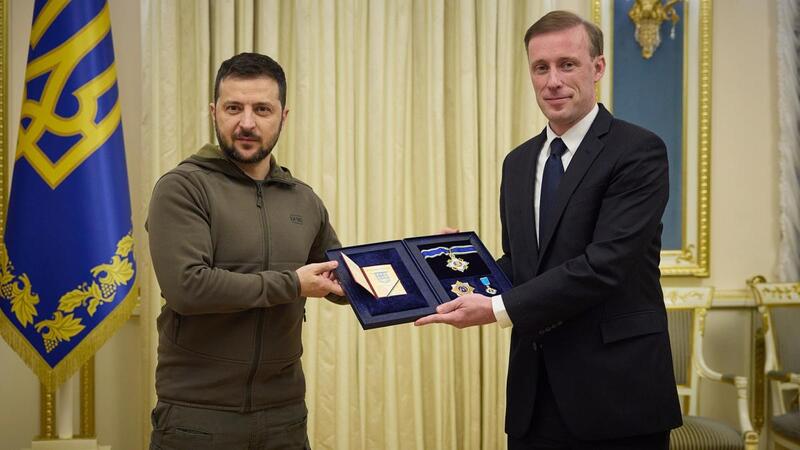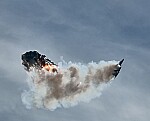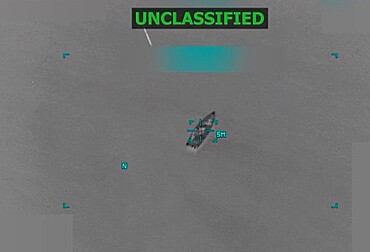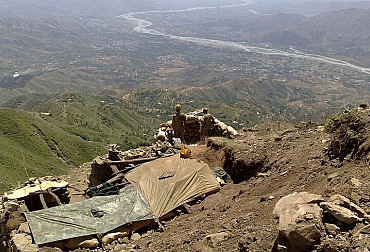Opinion: Does strategic sequence theory guide U.S. foreign policy?
It is obvious that the US can no longer conduct its foreign policy in a way that is inconsistent with its economic and resulting military resources. It is also obvious that this style of policy must be changed by the US and will have and is having major repercussions on our continent, specifically on the Czech Republic and its immediate surroundings.
Answers to the question of the next US strategy will have to be sought in the ability to focus on priorities, in building solid alliances, but also by changing the current paradigm of the entire system of international security relations. In this text, I will attempt to sketch the possible contours of these changes, using primarily Aaron Wess Mitchell's theoretical work on Strategic Sequence Theory, its practical recommendations, and their concrete form in the war in Ukraine.

Strategic Sequence Theory - Historical Parallels and the Present
Aaron Wess Mitchell is an American diplomat who worked for the administration of President Donald Trump from October 2017 to February 2019 as Under Secretary of State for European and Eurasian Affairs. After leaving the State Department, he founded The Marathon Initiative and wrote his thesis on Strategic Sequencing: How Great Powers Avoid War on Multiple Fronts for the Pentagon's internal think tank ONA in September 2020.
In this work, he describes examples of how four historical superpowers: Byzantium, Venice, Habsburg Austria, and the British Empire dealt with situations where they had to face more than one equal opponent at a time. It describes how these countries responded to these challenges, the strategies they chose, and the lessons that U.S. foreign policy might take from this.
Building on this scholarly work, Aaron Wess Mitchell published an article in The National Interest in August 2021 entitled Strategies for Avoiding War on Two Fronts, in which he applies these historical parallels to the current international situation and the U.S. position.
The author, like many other US establishment politicians and pundits, believes that the US cannot continue to distract itself around the world, but must focus on one challenge, namely, competing with China. This, after all, is evident from the 2018 US National Defence Strategy, which replaced the concept of two regional wars with inferior adversaries with the concept of one war with an equal adversary. However, this approach logically threatens U.S. interests elsewhere in the world, particularly in Europe, where Russia's expansionist approach could threaten the dominant position the United States has gained since the end of the Cold War. This, together with the apparent synchronisation of the foreign and military policies of Russia and China, presents the US with a dilemma to which it has not been accustomed in its history - namely, the risk of a clash on two fronts.
In his report, Mitchell offers several solutions that have historical analogies:
1. Get the weaker opponent on its side - at this point clearly the RF. This is the approach that Britain once took towards Tsarist Russia after its defeat in the war with Japan, and which both Barack Obama and Donald Trump undoubtedly wanted to pursue early in their mandates. The author rightly rejects this option at the time, because at the time of writing he sees no reason why the RF should reflect on this offer. From today's perspective, it should be remembered that the RF before 2022 would demand a very high counter-value for such an approach, which would at least negate all the gains made by the US after the end of the Cold War (from today's perspective, this thesis is confirmed in practice by the ultimatum presented on 17 December 2021 by the RF State Department). At the same time, it would be a moral hazard that could jeopardize the US position in the region that matters most to it - namely, Southeast Asia.
2. Postpone the rivalry with the stronger rival - i.e. China - and deal with the weaker rival - i.e. the RF. This strategy was used by Venice in the 16th century in its rivalry with Milan and the Ottoman Empire. In a situation where China is clearly pursuing its goal of global hegemony and has shelved its long-practiced policy of 'hiding', any attempt to reach an agreement would only serve to unnerve allies in the region and encourage China to pursue its aggressive policies.
3. Seek a constructive relationship with both adversaries and seek to engage them in international cooperation. However, according to the author, the method used by Klaus von Metternich in the 19th century is doomed to failure in a situation where both states clearly want to challenge the existing international order based on the dominance of the US and the collective West.
In conclusion, the author rejects all three of these options, based on historical parallels, and offers a different solution based on fear. The Russian Federation's fear of China. For this fear to be sufficient, it is necessary to ensure maximum dependence of the RF on China caused by its clear failure in its expansion to the West.
In his 2020 report, Mitchell describes how to successfully implement this strategy it is necessary to inflict a strategic defeat on the RF in the West, citing Ukraine as the fulcrum of this effort.
This would highlight the RF's strategic dilemma, where failure to expand in the West will be accompanied by extensive sanctions, further increasing Moscow's dependence on Beijing. At some point, Russian leaders may realize that they are putting themselves at a disadvantage and initiate a policy of détente with the West to reduce their dangerous dependence on China.
In other words, Russia will find itself in a similar situation to the one it found itself in after the lost war with Japan in 1905, when Great Britain was able to enlist it in a coalition against Wilhelmine Germany because it had encountered a powerful adversary in the East. The only difference, then, is that it will be in the opposite geographical direction and that Russia's hard clash with Japan was not caused by Great Britain, whereas Russia's hard clash in the Ukraine may have been brought about by US and Western policy.
In the next section of my paper, I will provide the telltale signs that the US is practicing this policy in the Ukraine conflict.
The hallmarks of the application of strategic sequencing in the war in Ukraine
It is certainly not and was not within the power of the United States to influence the RF to decide to wage war in Ukraine. The RF is a state in its own right, which decided to engage in this act of war of its own volition and for its own reasons. What the US could have done, however, was to maximize the possibility of this war. We will not dwell on the long-term strategy of the US after the end of the Cold War, when, by controlling the perimeter from the Baltic to the Black Sea, it gained an instrument of pressure on the RF's sensitive point - the western border, the culmination of which was the effort to bring Ukraine and Georgia into NATO in 2008. This is an unquestionable historical foundation, but one on which the US could build its subsequent actions.
Indeed, according to Polish analysts Jacek Bartosiak and Albert Swidzinski, there are clear signs that the US brought the war closer and made no effort to prevent it:
1. They did not create the impression of a clear deterrence, as they did, for example, with Taiwan - no military guarantees to Ukraine, no large arms deliveries, no deployment of military assets in Ukraine, a clear declaration of non-participation of US troops in a possible conflict. President Biden even declared that 'the US will not respond to a minor attack'. There were more than enough signals from which the Kremlin, bolstered by the conviction of a quick victory, could infer that the time was right to invade with impunity. All the greater, and unexpected by many, was the harshness of the subsequent reaction, first by the US and then by the West.
2. The US did not pursue a policy of appeasement towards Russia. While an offer was made to negotiate on certain parts of the RF ultimatum, no substantive answers to Russian demands were given, and at the same time no guarantees were given regarding Ukraine's non-alignment with NATO, quite the opposite.
3. Unprecedented intelligence sharing with the world and the media. By sharing information about the evil intentions of an adversary, it is undoubtedly put under pressure, is clearly identified as the aggressor and is forced to react.
All of this, in my view, corresponds with sufficient but not essential aid to the invaded country. This aid is undoubtedly a key factor in why Ukraine is still able to resist Russian pressure, but it is certainly not sufficient for its overall victory. The US objective, therefore, is not the defeat of Russia, which has undoubtedly already occurred at a strategic level, but the objective is Russia's 'non-victory' in this conflict and the desire to let Russia bleed to death. As Mitechell has already described in his report, the aim was and is for Russia to experience a second Afghanistan. The question is the length of time Russia will be willing to continue to bleed and the US will be willing to continue to pursue this region of Europe when they have more important goals in Southeast Asia. The signs that this is no longer a priority for the US are already apparent. The reason is clear - the plan has been executed and has unalterable consequences.
Implications of the application of this strategy for the situation in Ukraine and Europe
1. the level of defense spending by European NATO members has risen and will continue to rise to a level sufficient to sustain long-term pressure on the RF without the need to increase U.S. involvement. The US will retain dominance only at the level of strategic nuclear deterrence. All of this is also being done with the participation of US arms factories - see the delivery of the F35, the ESSI missile defence system.
2. It has strengthened NATO unity to - at the moment - an unprecedented level, which before the war, given the divergent geopolitical interests of France, Germany and the US, seemed impossible.
3. The entry of Finland and Sweden into NATO completes the geopolitical dimension of the Three Seas Project (BABS), which will be a permanent threat to the RF under US patronage.
4. With sanctions comparable perhaps only to those against the DPRK and Iran, the RF's dependence on China has increased to a degree that only a few years ago was imaginable only in the science fiction novel "The Day of the Oprichnik" by Vladimir Sorokin. The question is how long the Russian elites will be comfortable with this state of affairs.
5. The war has substantially reduced the military, demographic and economic potential of the RF, and for a long time. To illustrate: the US, for a few percent of its military budget, eliminated 87% of the active personnel of the pre-war ground forces of the Russian Federation and 2/3 of the tanks it had in active service before the invasion.
What can bring about a change in Russian thinking?
Nevertheless, the implementation and success of the described strategy is very uncertain. For the RF, whose essential infrastructure of the entire state is located in the western part of the territory, the idea that it should primarily orient itself towards the East will be hard to imagine. Believing that there will be no danger from the West in a situation where it is surrounded by historical enemies in a region stretching from the North Pole to the Bosphorus Straits - Scandinavia, the Baltic states and Poland, the perennially hostile Ukraine and old rivals Romania and Turkey - is probably quite difficult. Moreover, since the end of the Cold War, the RF has been deprived of its strategic depth, which reinforces a historical sense of encirclement among Russian elites.
What can bring about a change in Russian thinking? For one thing, the entire project of encircling its western border is built on the US guarantee and will not be downright dangerous to the RF without its support. And secondly, China's own behaviour may bring about the change. China sees the multipolar world invoked by Russia only as a prelude to the emergence of a "new order of Tachung", which in Chinese terms (and correctly translated) is purely unipolar, and who is the ruler in this order - there is no need to doubt it. The U.S. has already succeeded in this move once before, when, as part of a policy of détente towards the USSR, it was able to divert Russian attention towards the East - see U.S. MFA Henry Kissinger's warning to his counterpart Zhou En-Lai in October 1971: "Moscow would like to detach itself from Europe in order to concentrate on other areas." By other areas he meant the PRC.
In conclusion, let me make one remark directed at Czech foreign policy, based on a very astute observation by the above-mentioned Polish political scientists: 'If Ukraine was to be a second Afghanistan for Russia, what role was Poland to play? - It should have played the role of Pakistan."
Yes! It is necessary to be realistic about what the entire Eastern European region means to the US. It has undoubted strategic value for them, but only in a certain context and time. It is not, and especially in the future will not be, a core area of their interest. Yet this region is totally dependent on US security guarantees. We therefore need to think deeply about whether we should not focus on a patronage primarily controlled by closer, and for us more familiar, actors - Berlin, Paris and Brussels. There is no doubt that the Germans, for example, will always care more about their immediate and historical surroundings than Washington.








